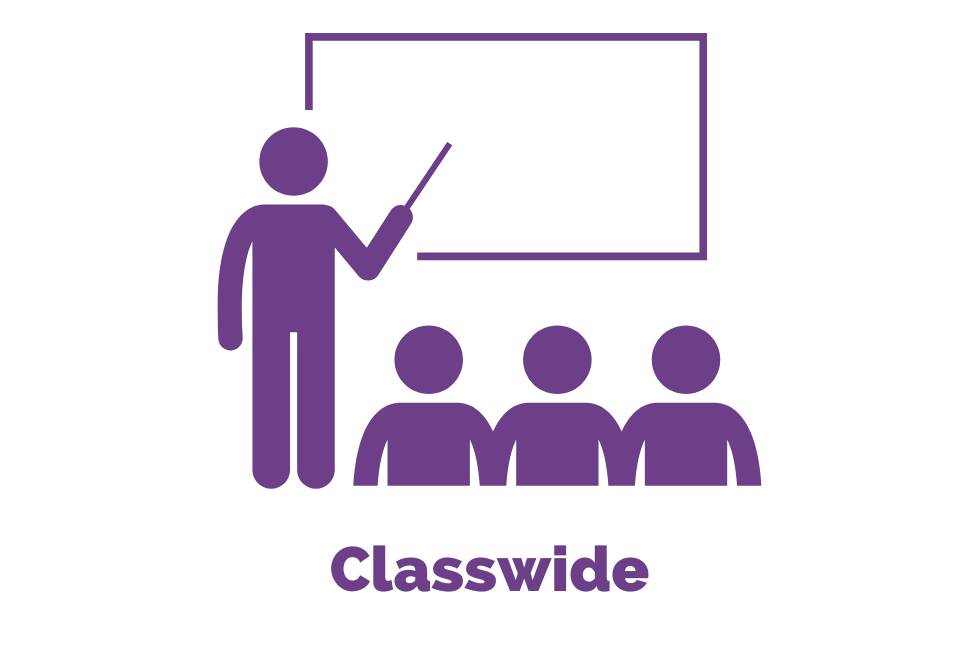Due to forecasted weather conditions, the university has implemented REMOTE STATUS on Friday, December 19, 2025. Students, faculty, staff, see email for more information.
Behavioral Response Scripts: Whose Line is it?
This article originally appeared in START Connecting in February 2024.
Did you know that approximately ⅔ of the content on the nine major streaming platforms is scripted programming? Yet many of us still enjoy a good unscripted program, like House Hunters or Real Housewives. Why do we like unscripted TV? Is it because of the voyeuristic nature of watching a couple decide which home to buy or to escape our day-to-day reality and see how the “other half” lives? Maybe! Unscripted shows have a time and place, but not at school! This article focuses on scripted interventions in schools, particularly behavior intervention scripts, to support educators and students and why they should be in 100% of schools.

What is an intervention script?
Barnett, Bell, & Carey (2002) defined scripts as “personalized and detailed guidelines for providing instructions and/or managing behaviors to meet specified goals” (p.91).
Some academic intervention programs include a script in the teacher manual providing specifics of what an instructor/interventionist says and does during the instruction, including specific positive feedback and error corrections. While some educators may complain that scripted instruction is clunky or robotic, Cooke et al. (2010) found higher rates of on-task instructional opportunities for students and decreased off-task behavior with scripted instruction. In addition, both the paraeducators providing the instruction and the students preferred the scripted instruction.
When addressing behavior, scripts serve a similar purpose to increase or maintain student engagement by ensuring consistent adult responses to student behavior to support student self-regulation, prevent or reduce behavioral escalation, and help students return to a calm and engaged stage.
Why scripts?
As much fun as it might be to watch an unscripted TV show, having an unscripted behavior plan is less than appealing. Not knowing what to do or say to support a student trying to regulate their behavior could lead to missed opportunities for learning in a best-case scenario or unexpected and potentially unsafe responses in a worst-case scenario.
Scripts have several benefits for staff and students, including:
- Provide predictability and consistency for both staff and students
- Neutralize the emotionality of staff
- Empower staff – minimizing impromptu strategies by predetermining what to say and do
- Counteract some of our natural human tendencies
- Minimize inadvertent reinforcement of the interfering behavior
- Prevent adult responses that further escalate the behavior or dysregulate the student
- Increase fidelity of implementation of the plan
- Support students in staying in and returning to a calm and engaged stage
- Reduce opinion debates
- Identify areas of needed staff support
Scripts are our method of organizing, delivering, and internalizing our responses to support students in school. They can and should be utilized across the various levels of behavioral responses. To do this well, the team should have training in understanding the behavior response cycle, script development, and behavior science. The Behavioral Response Script Development Template and the Behavior Script Development Guide can assist teams in developing the scripts. Behavioral response scripts can be developed as classwide support or to support individual students.
What goes into the script?
An intervention script is a step-by-step guide of what adults will say and do to support students behaviorally and academically. Sometimes, a script may also include specifics of what the adult should not do. For example, if a student’s behavior accelerates, adults will want to minimize the language used when supporting the student. Too many words could further escalate behavior unintentionally. The goal of the script is to take the guesswork out of supporting students and give the adults the specifics of what to do.
Scripts are collaboratively developed with the family, staff supporting the student, and the student themselves, if appropriate. Having the team develop the scripts will support buy-in by allowing everyone a chance to have a voice in the content of the scripts. Once scripts are drafted, the team should practice and role-play using the script. This often reveals gaps in the scripts that can be addressed before using the behavior scripts.
A further script enhancement may include space to record if each step was followed. This allows for fidelity data collection. Knowing if the intervention is implemented as designed is a helpful data source when the team comes together to review the student’s progress. Behavior plans are about changing adult behavior to support student engagement. Fidelity data lets us know if we, as adults, are on track with the plan or need more support or to adjust the plan.
Key Takeaway Message:
When addressing behavioral support, scripts serve the purpose of supporting student engagement by supporting adult behavior. Behavioral response scripts are our method of organizing, delivering, and internalizing our responses to support students in school. Keep the unscripted situations to TV and not in schools!
Written by: Melissa Nantais, Ph.D., BCBA - MiMTSS Technical Assistance Center, Advanced Tiers Coordinator and Stephanie Dyer, Ed.S., BCBA - START, Autism Education and Intervention Specialist
References
Barnett, D.W., Bell, S.H., & Carey, K.T. (2002). Designing preschool interventions: A practitioner’s guide. Guilford Publications.
Cooke, N.L., Galloway, T. W., Kretlow, A. G., Helf, S. (2010). Impact of the script in a supplemental reading program on instructional opportunities for student practice of specific skills. The Journal of Special Education, 45(1), 28-42.



